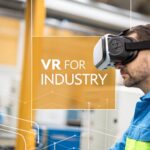Augmented Reality in Business: A Practical Guide to Transforming Your Operations
While augmented reality often brings to mind video games or futuristic sci-fi movies, its application in the business world is grounded in function, not fantasy. It is a powerful tool that overlays digital information—like data, images, or step-by-step instructions—directly onto the real-world environment.
This act of bridging the digital and physical worlds creates interactive experiences that solve tangible business problems. This is a technology that can boost efficiency, increase sales by up to 40%, and provide a significant competitive advantage.
What Is Augmented Reality in a Business Context?
In a business setting, AR is a practical, strategic layer of information that enhances physical operations. Using the camera on a smartphone, tablet, or smart glasses, AR takes a live view of the world and superimposes relevant data precisely where it is needed. The implications for how companies train employees, operate machinery, and interact with customers are substantial.
For businesses, AR is about solving tangible problems. It’s giving a field technician instant access to repair schematics without them ever having to look away from the machine they're fixing. It's letting a customer see exactly how a new sofa would look in their living room before they make a purchase. To better understand its immersive capabilities, it helps to review the broader landscape of how AR, MR, and VR are revolutionizing user experience.
Beyond Theory to Practical Application
The true value of AR in business is its ability to deliver the right information, at the right time, in the most intuitive way possible. This isn't just data on a screen; it's contextual intelligence that helps employees make smarter, faster decisions and gives customers the confidence to make a purchase.
The benefits are already being realized in major industries:
- Improved Efficiency: Warehouse workers can be guided along optimal picking routes, or an assembly line employee can see the exact sequence for a complex build, reducing errors and increasing speed.
- Enhanced Training: Complex procedures can be taught with interactive, 3D tutorials overlaid on actual equipment, significantly improving knowledge retention and safety.
- Increased Sales and Conversions: Virtual try-on for apparel or product visualization for furniture allows customers to interact with items in their own space, boosting purchase confidence.
- Reduced Operational Costs: With AR-powered remote assistance, an expert can guide an on-site technician from anywhere in the world, slashing travel costs and equipment downtime.
By integrating digital insights into the physical workspace, augmented reality fundamentally changes how information is accessed and used. It moves data from a static screen into the dynamic environment where work actually happens.
A New Layer of Business Intelligence
Ultimately, the goal is to make business processes smarter and more intuitive. By connecting the physical and digital worlds, companies are unlocking new levels of productivity and creating customer experiences that were not previously possible.
It’s a fundamental shift away from abstract data and toward actionable, real-time intelligence. For a deeper dive into how different companies are already putting this to work, our comprehensive guide on augmented reality for businesses is packed with more examples.
Understanding the Core AR Technologies
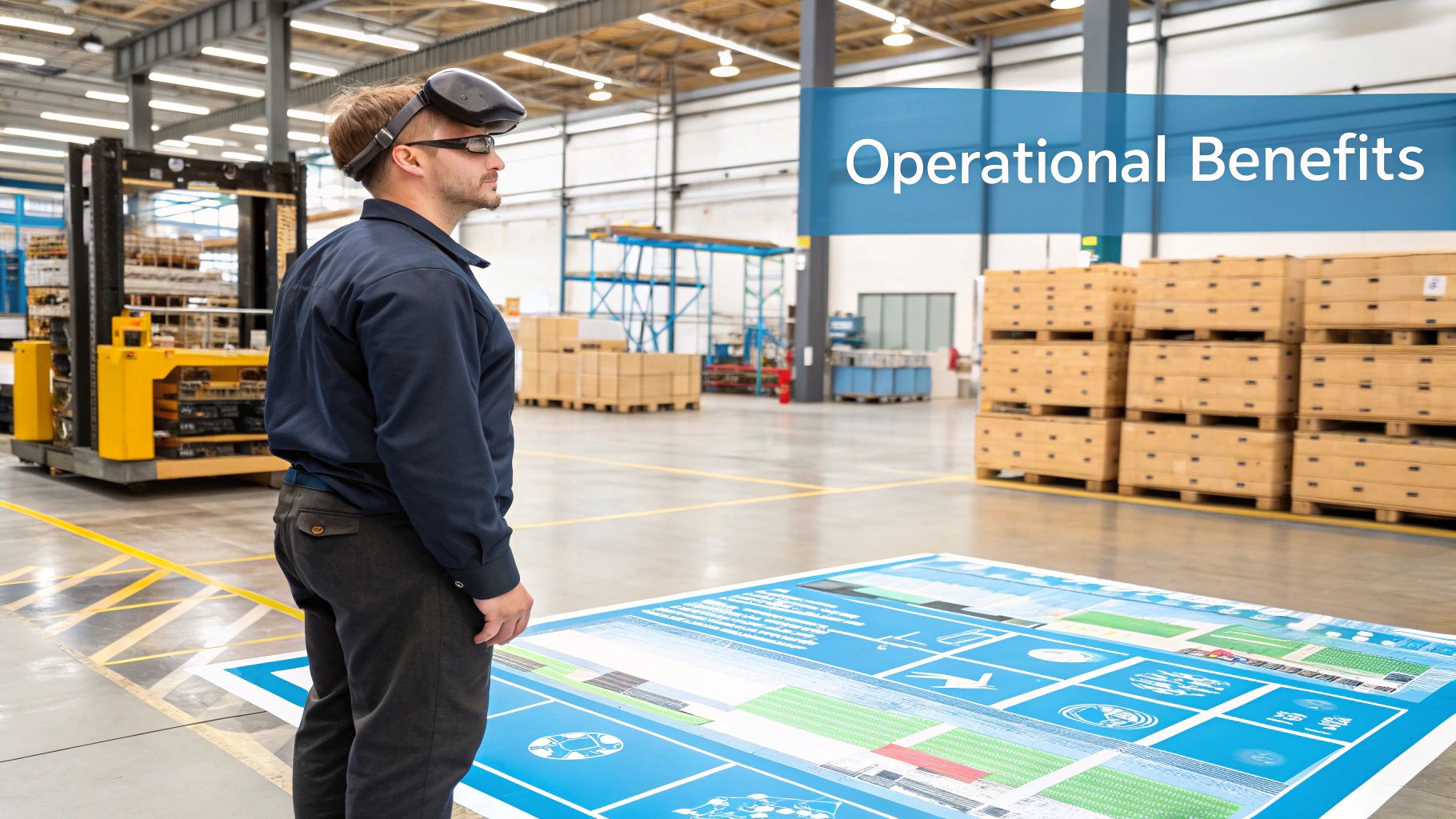
Before implementing augmented reality, it's important to understand the different technologies that enable it. Each type offers a unique way to connect the physical and digital worlds, designed to solve specific problems. Understanding these core concepts allows you to select the right tool for the job and ensure your AR project delivers real value.
The explosive growth in this space signals its impact. The global AR market recently hit a valuation of around $62.9 billion and is expected to grow to $87.3 billion in the next year. This is driven by deep integration into retail, healthcare, and manufacturing. Analysts predict the market could reach $1.87 trillion by 2032. You can explore more statistics and projections for the augmented reality market to see the scale of this trend.
Marker-Based AR
Marker-based AR is one of the most common forms of the technology. It functions like a digital key that unlocks a hidden layer of information. This "key" is a specific visual cue—typically a QR code, an image, or a logo—that an AR application recognizes through a device's camera.
Once the application identifies the marker, it triggers a pre-programmed digital experience, such as a 3D model, an animation, or a video appearing on top of the physical marker.
Practical use cases include:
- Interactive Packaging: A customer scans a QR code on product packaging, and an animated character or product information appears on their screen.
- Engaging Print Media: A reader points their phone at an image in a magazine, launching a behind-the-scenes video.
- Smarter Business Cards: Scanning a business card can instantly bring up a link to a portfolio, a video introduction, or a pre-filled contact card.
This approach is reliable and straightforward to implement, making it an excellent entry point for businesses looking to add a digital dimension to their physical products.
Markerless AR
Markerless AR, as the name suggests, does not require a specific trigger image. Instead, it relies on sophisticated algorithms and a device’s sensors—like the GPS, accelerometer, and gyroscope—to understand and map the physical environment in real-time. This allows it to place digital objects into a real-world space with remarkable accuracy.
This is the technology behind "virtual try-on" applications for furniture or apparel. It analyzes surfaces like floors and walls to realistically anchor a virtual object in your environment. These advanced capabilities are often enhanced by other systems; you can read more about how AI is revolutionizing AR and VR technologies in our guide.
The primary advantage of markerless AR is its flexibility. It turns any real-world location into a potential stage for an interactive digital experience, without the need for pre-placed markers.
Projection-Based and Superimposition AR
Two other powerful forms of AR enable more specialized applications.
-
Projection-Based AR: This technology projects digital light and information directly onto physical surfaces, creating an interactive display without a screen or headset. It is ideal for eye-catching retail installations or guiding complex assembly tasks in manufacturing by illuminating specific parts or steps.
-
Superimposition-Based AR: This type replaces the original view of an object with an augmented one, either partially or completely. For example, a technician could point their tablet at a complex engine and see a digital overlay of its internal components. This is a transformative tool for maintenance, repair, and medical training.
How AR Transforms The Customer Experience
Augmented reality is fundamentally changing how businesses connect with their customers. It moves beyond passive browsing, inviting shoppers into an interactive, personal experience that directly influences their purchasing decisions. This is where AR demonstrates its value, turning casual interest into active engagement.
By overlaying digital products onto a customer's real-world environment, AR dismantles one of the biggest hurdles in online shopping: uncertainty. This technology empowers customers to visualize, interact with, and feel confident about a product before they commit to a purchase.
The Power Of Virtual Try-On
One of the most impactful applications of augmented reality in business is the virtual try-on. For industries like fashion, beauty, and accessories—where fit and appearance are critical—this feature is a true game-changer.
Instead of guessing how a pair of glasses might look or what shade of lipstick complements their skin tone, customers can use their smartphone camera to see the product on themselves in real time. This brings the in-store fitting room experience into the customer's home.
Here’s why it is so effective:
- Boosts Purchase Confidence: When a customer can see how a product looks on them, their confidence to make a purchase increases significantly.
- Reduces Return Rates: A clear pre-purchase visualization means fewer surprises upon delivery, leading to a major reduction in costly returns.
- Drives Deeper Engagement: The interactive nature of a virtual try-on keeps shoppers on product pages longer and encourages them to share their experience on social media.
Visualizing Products In Your Own Space
This "try before you buy" concept extends far beyond fashion. For businesses selling furniture, home decor, or large appliances, AR solves a long-standing challenge. Shoppers no longer have to guess whether a new sofa will fit their living room or if a paint color will match their existing decor.
With a simple markerless AR application, a customer can place a true-to-scale 3D model of a product in their physical space. They can walk around it, view it from different angles, and ensure it’s the perfect fit. This is a practical tool that removes the guesswork from major purchasing decisions.
The infographic below highlights the tangible results retailers are seeing after integrating AR.
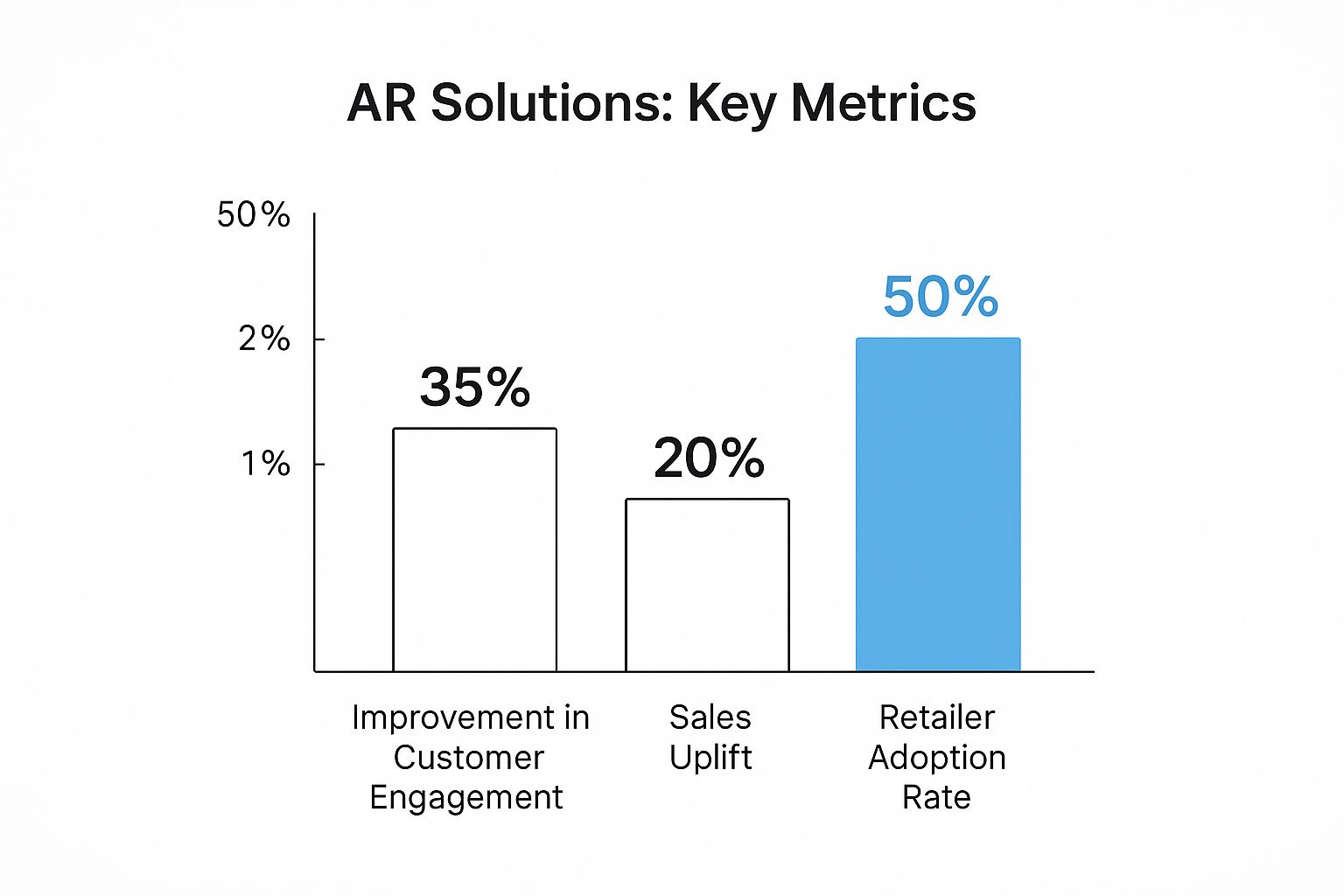
The data is clear. AR integration is no longer a novelty; it's driving measurable improvements in engagement, sales, and overall adoption for businesses seeking a competitive edge.
From Browsing To Experiencing
At its core, AR transforms the customer journey from a flat, two-dimensional scroll into an immersive, three-dimensional experience. It bridges the gap between the convenience of online shopping and the tangible feedback of seeing something in person.
The results speak for themselves. The table below illustrates how dramatically the customer journey can shift when AR is integrated.
AR Impact on Key Retail Metrics
| Metric | Without AR Integration | With AR Integration | Reported Improvement |
|---|---|---|---|
| Conversion Rate | Standard e-commerce averages (2-3%) | Up to 40% higher | Significant sales lift |
| Customer Engagement | Passive browsing, short session times | Active interaction, longer sessions | 2-3x longer on-site |
| Return Rate | As high as 30% in some categories | Reduced by up to 25% | Lower operational costs |
| Purchase Confidence | High uncertainty, cart abandonment | High confidence, reduced hesitation | 71% of shoppers would shop more often |
These figures demonstrate that AR isn't just improving existing metrics—it's creating entirely new levels of customer interaction and satisfaction.
The performance boost is undeniable. For instance, some retailers using AR have reported conversion rates up to 40% higher than those without it. This aligns with consumer sentiment, as 71% of shoppers say they would shop more frequently if AR were an option. Industries like fashion are seeing incredible growth, with virtual try-on adoption jumping by over 200% since 2023.
AR doesn't just show customers a product; it allows them to experience it in the context of their own lives. This shift from passive viewing to active participation is what builds brand loyalty and drives conversions.
This dynamic creates memorable moments that differentiate a brand. Whether a customer is testing a new look or redesigning their home, AR offers a practical and engaging tool to support their journey. These interactions are just one example of the wide range of powerful augmented reality applications that businesses are leveraging today. By turning a simple shopping session into a personalized experience, AR proves its value as an essential tool for both customer satisfaction and business success.
Boosting Operational Efficiency with AR
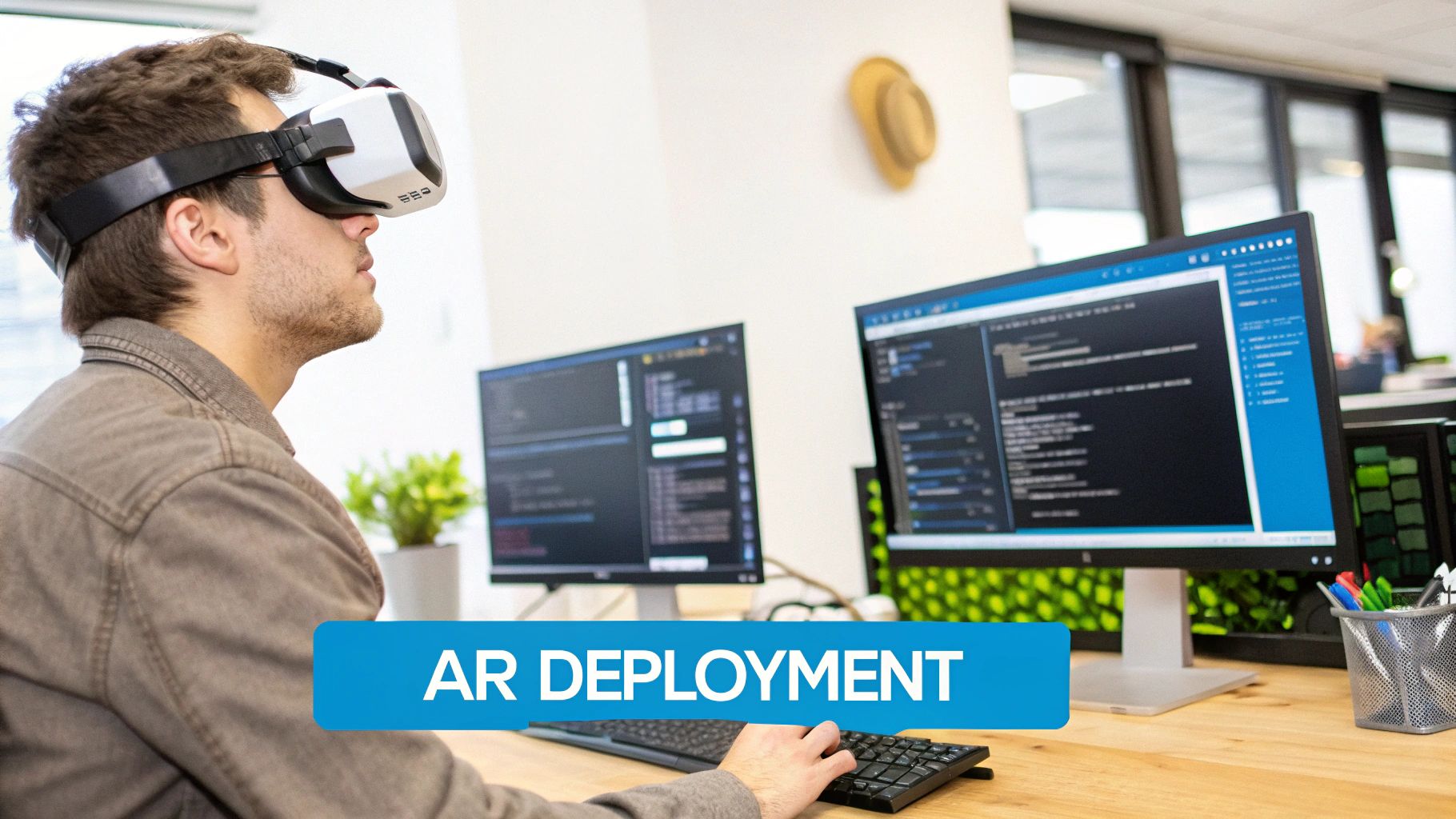
While AR is a game-changer for the customer journey, its power to enhance internal operations is equally significant. Overlaying critical digital information onto the physical world provides employees with the tools to work faster, smarter, and more safely. This is where the technology shifts from customer engagement to driving core productivity.
Workers can receive real-time, contextual guidance right where they need it, when they need it, without cumbersome manuals or screens. This immediate access to information reduces errors, minimizes mental load, and empowers teams to tackle complex jobs with confidence. The result is smoother workflows and a significant boost in operational output.
Streamlining Complex Assembly and Manufacturing
In a manufacturing setting, precision is paramount. Minor mistakes can lead to costly rework or safety incidents. AR provides a powerful solution by delivering visual, step-by-step instructions directly into a worker’s line of sight, often through smart glasses.
Imagine an assembly technician looking at complex machinery. Through their AR device, they see digital arrows pointing to the exact screw to tighten, animations showing the proper motion, and data readouts confirming the correct torque. This digital guide ensures every step is performed correctly and in the right sequence.
This approach delivers significant advantages:
- Drastically Lower Error Rates: Visual guidance reduces human error. Some operations have seen up to a 90% improvement in first-time accuracy.
- Accelerated Training: New hires can be brought up to speed in record time, as the AR system acts as an expert mentor guiding them through each task.
- A Safer Workplace: AR can highlight hazardous zones, display critical warnings, and ensure safety protocols are followed precisely.
Optimizing Logistics and Warehouse Operations
The modern warehouse is a fast-paced environment where efficiency is measured in seconds. AR is making a significant impact by enhancing key logistics processes like order picking and inventory management, transforming the warehouse floor into a smart, interactive space.
Warehouse staff wearing AR devices can be guided along the most efficient route to find a specific item. Their display can highlight the correct bin, show product details, and confirm the pick—all without the need for a handheld scanner or paper list. This "vision picking" system makes the entire fulfillment process faster and far more accurate.
By transforming a worker's field of view into an interactive, data-rich environment, AR minimizes wasted motion and decision-making time. It provides logistics teams with a real-time GPS and digital checklist in a single interface.
This operational uplift is happening now. The rapid adoption of AR is proof of its practical value. Globally, it’s estimated that 75% of the population will be using AR technology by 2025, moving it from a niche tool to a mainstream platform. High-frequency use on platforms like Snapchat, where over 300 million users interact with AR daily, shows how comfortable people are becoming with it. You can learn more about the future of AR for consumers and businesses to get a sense of its expanding role.
Revolutionizing Maintenance and Remote Assistance
One of AR's most valuable applications is in maintenance and repair, particularly for field service teams. When complex equipment fails, dispatching an expert to the site is slow and expensive, leading to significant downtime. AR-powered remote assistance completely changes this model.
An on-site technician can use a smartphone or smart glasses to share their live point-of-view with an expert located anywhere in the world. The remote expert sees exactly what the technician sees and can guide them in real-time by drawing digital annotations, displaying schematics, or sending instructions that appear directly on the technician's screen.
This ability to instantly connect experts with frontline workers is a massive operational win, cutting travel costs and resolving issues in a fraction of the time. You can explore a detailed breakdown of how businesses are using augmented reality for maintenance to see how effective this strategy can be. This immediate, expert-level support empowers your team and maintains operational continuity.
Crafting Your AR Implementation Strategy
Adopting a powerful technology like augmented reality without a clear plan can lead to wasted resources. A well-defined strategy is what separates a flashy demo from a genuine business success. The objective isn't simply to "use AR"—it's to solve a specific, high-value problem within your organization.
Successful AR projects start with a pain point, not with the technology itself. Identify where immersive, real-time information can make a measurable difference. That is the starting point for a successful implementation.
First Things First: Define Your Business Objectives
Before evaluating hardware or software, you must define what you are trying to accomplish. A vague goal like "we want to be more innovative" is insufficient. Be specific about the business outcome you are aiming for.
Your objectives must be tied to clear Key Performance Indicators (KPIs) to measure success.
- To boost the customer experience? Your metrics are conversion rates, time spent on a product page, or a reduction in product returns.
- To improve operational efficiency? You should track KPIs like error rates in assembly, training times for new hires, or travel costs for expert support.
Establishing these metrics from the outset provides a baseline to prove the value of your AR solution and justify future investment.
Choosing Your Path: Build vs. Buy
With a clear objective, you face a critical decision: build a custom AR application from scratch or license an existing AR platform. Each path has distinct advantages and disadvantages, and the right choice depends on your budget, timeline, and the uniqueness of your requirements.
This is a major strategic decision. A custom build offers total control, tailored to your exact needs. A platform provides a faster time-to-market with lower upfront costs and built-in scalability.
Building a custom application ensures that every feature and workflow is perfectly designed for your processes. However, this path requires a significant investment in specialized developers, longer development timelines, and an ongoing maintenance budget.
Conversely, licensing an existing AR platform is a much faster and more cost-effective way to get started. These platforms come with ready-made tools for common use cases like remote assistance or interactive training guides. While you may sacrifice some customizability, you gain a system that is built to scale and is continuously improved by the provider. For companies planning their AR initiatives, exploring specialized 3D and AI platforms like vibe3d.ai can be a strategic move to anchor a strong implementation strategy.
Picking the Right Hardware for the Job
The final piece of your initial strategy is hardware selection. The device you choose fundamentally shapes the user's interaction with the AR experience. The choice typically falls into two main categories:
-
Smartphones and Tablets: This is the most accessible option, as most employees and customers already own one. The low barrier to entry makes them ideal for customer-facing applications like virtual try-ons or for many internal tasks where hands-free operation is not critical.
-
Smart Glasses and Headsets: For tasks that require hands-free operation, smart glasses are the superior choice. A technician repairing machinery or a warehouse worker picking an order cannot be encumbered by a phone. These devices place information directly in the user's line of sight, making them the standard for complex, hands-on operational work.
By starting with a problem, defining success metrics, choosing a development path, and selecting the right hardware, you lay a solid foundation for an AR project that delivers measurable value.
The Future of AR in the Business World
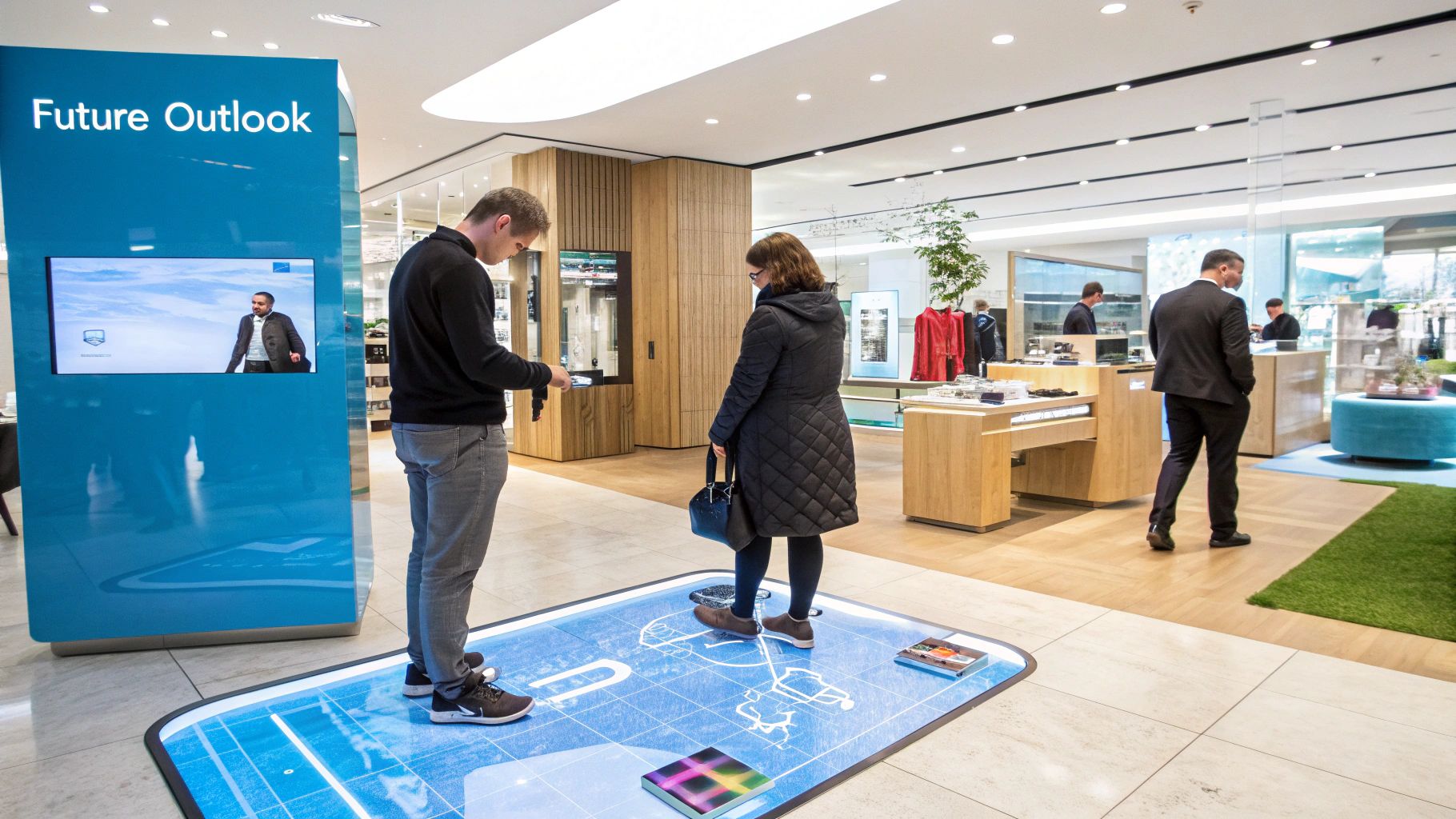
We are moving beyond the era of AR as a collection of standalone applications. The next evolution for augmented reality in business involves creating fully connected, intelligent workspaces. This means a convergence of AR with other key technologies like Artificial Intelligence (AI) and the Internet of Things (IoT) that will completely reshape how work is performed.
When AR integrates with AI and IoT, operations become not just more efficient, but smarter.
Consider a factory floor. An AR headset is not just displaying a schematic to a technician. It is pulling live data from IoT sensors embedded in the machinery. An AI analyzes this data, detects an anomaly, and predicts an imminent failure. The AR system then instantly guides the technician through the precise pre-emptive repair. This is the difference between reacting to a breakdown and proactively preventing one.
The Rise of Accessible Workplace Hardware
One of the key drivers of AR adoption is the hardware itself. The bulky, first-generation headsets are being replaced by lightweight, comfortable smart glasses that are suitable for all-day use.
This development is critical. As the hardware becomes more user-friendly and affordable, these devices will become standard equipment in many professional roles.
A surgeon, an engineer, or a logistics manager will have critical data available in their line of sight when needed, without being encumbered. This shift will establish AR as an ever-present tool, woven directly into daily workflows rather than reserved for special tasks.
The future of AR in the workplace is not about introducing a single piece of technology; it's about building a smarter operational fabric where digital intelligence and human action are perfectly aligned.
The path forward for augmented reality is clear. It is cementing its place as an essential technology for any business focused on innovation and efficiency. With hardware improving daily and the powerful integration with AI and IoT, AR is no longer a future concept. It is a tool that businesses can use today to remain competitive.
Got Questions About AR in Business? We've Got Answers.
Adopting augmented reality can seem like a significant undertaking, and it's natural to have questions about where to start, what it costs, and which industries are benefiting the most. Here are answers to some of the most common questions.
How Do I Take the First Step with AR?
The best starting point is to identify a single, high-value problem that AR could solve. Do not adopt the technology for its own sake. Instead, find a real bottleneck in your operations or a point of friction in your customer's journey.
Consider common pain points:
- "Try before you buy": Can you help customers visualize how a product would look in their home?
- Complex training: Could you overlay digital instructions on machinery to make training more hands-on and intuitive?
- On-site support: Can you enable an expert to guide a field technician through a complex repair remotely?
Once you have a clear use case, you can set tangible goals and measure your results. This transforms your AR project from an experiment into a strategic investment with a clear return.
Is AR Too Expensive for a Small Business?
Not anymore. While custom AR application development can be a significant investment, the barrier to entry has lowered dramatically. Today, many AR platforms offer subscription-based models that make the technology much more accessible and scalable.
Furthermore, since nearly every modern smartphone is AR-ready, you often do not need specialized hardware for customer-facing projects. The key is to start with a small, manageable project that has a clear ROI, prove its value, and then scale your efforts.
The fact that billions of people already carry an AR-ready device in their pocket has been a game-changer. It allows businesses of all sizes to create immersive experiences without a massive upfront hardware investment, making it easier than ever to test, learn, and grow your AR initiatives.
Which Industries Are Winning with Augmented Reality?
A few industries are leading the way in AR adoption because the technology delivers immediate and powerful results for their specific challenges.
Retail and eCommerce are achieving significant gains. They use AR for virtual try-ons and in-home product previews, which has been shown to boost conversions by as much as 40%. In the manufacturing and industrial sectors, AR is a go-to tool for streamlining assembly, guiding maintenance, and providing remote expert support, leading to major improvements in efficiency and worker safety.
Healthcare is another key sector, where AR is used for surgical training, patient education, and overlaying critical medical data during procedures. In addition, marketing and advertising teams are using AR to build immersive brand experiences that capture consumer attention in a way that static ads cannot.
Ready to see how a proven AR solution can transform your operations? AIDAR Solutions provides immersive training and remote service tools that slash costs and dramatically boost efficiency. Discover how our applications can deliver a rapid return on investment for your business.


